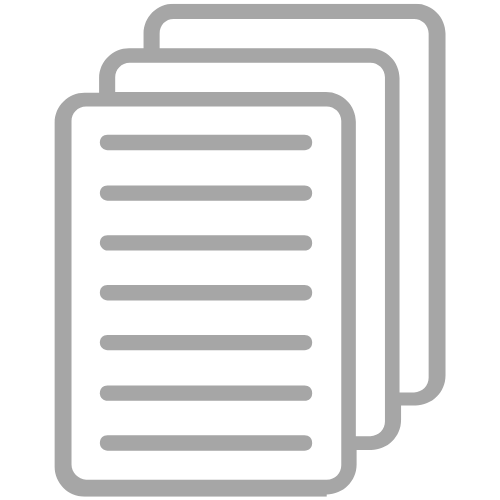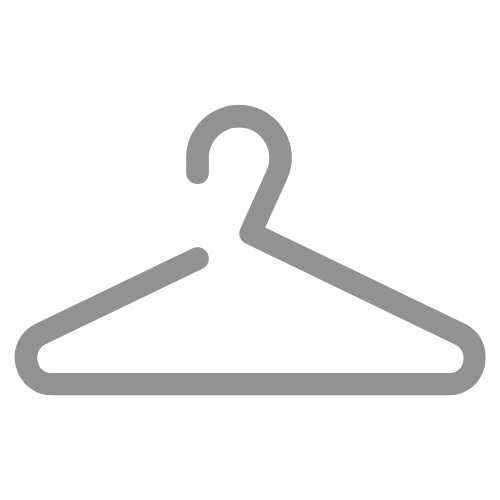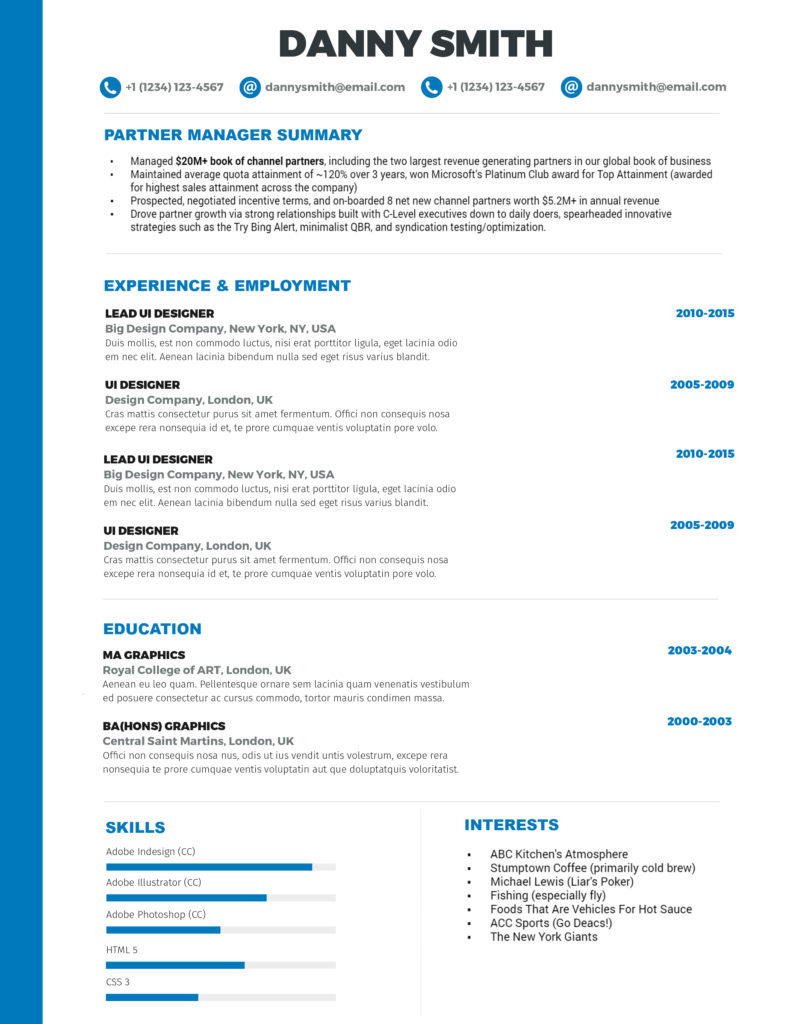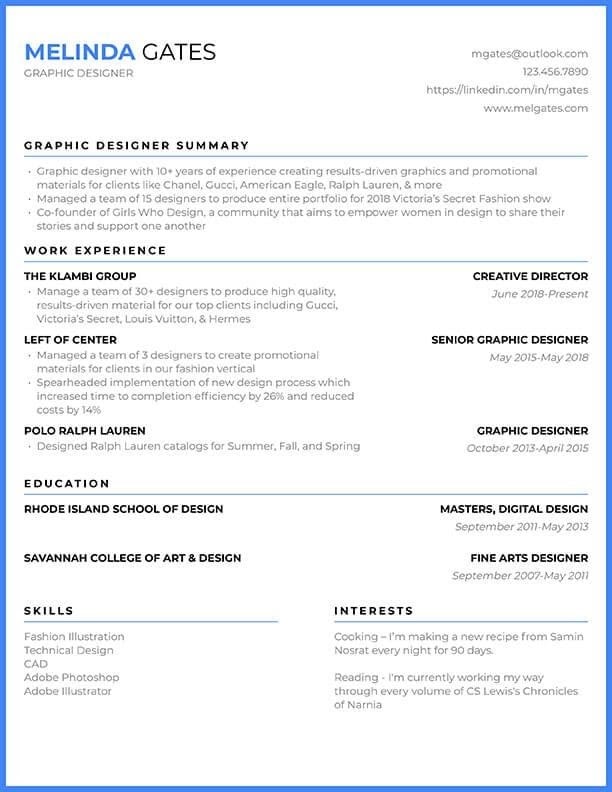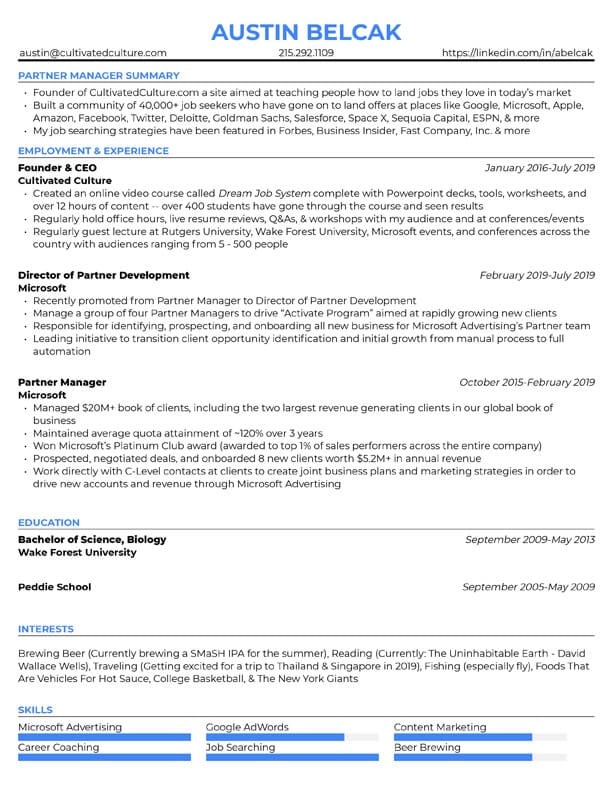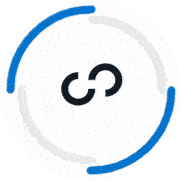Competition in the job market is stiff. According to the Organization for Economic Cooperation and Development, COVID-19 is causing economic activity to collapse and unemployment to soar. The pandemic’s impact on jobs has been ten times bigger than that of the global financial crisis of 2007 to 2008.
With more people looking for work, you must find creative ways to stand out. Your resume is the first thing potential employers will see, so it makes sense to start there. Read on to learn how to build a creative resume that will get you in front of the right people.
Include Only Relevant Details
Contrary to popular belief, more information in a resume isn’t necessarily better. Don’t feel the need to include your entire work history. Remember, your resume's job is to convince your potential employer that you have the skills for the post you’re applying for, and a creative resume will help make it stand out.
Take a look at this pared-down resume:
Danny’s expertise and experience are evident at a glance, and you should aim for the same thing with your resume. If you’re applying to be a graphic designer, your experience as a salesperson while you were in college probably isn’t relevant.
A simple rule of thumb: if it doesn’t strengthen your candidacy for this job, don’t make it the main focus.
However, that doesn’t mean you should only include experience in roles with a similar title or in the same industry. Transferable skills are valuable. You just need to make sure they’re directly relevant to the role you’re hoping to land, and a creative resume will help you do that.
Customize Your Creative Resume
Like most job seekers, you are probably applying for multiple positions. Don’t be tempted to send the same resume each time. Instead, tailor your resume to each application to highlight only the most relevant skills and experience. This type of creative resume shows the hiring manager that you have the skills needed for the role and will increase your chances of getting an interview. It also shows you really want the position.
If you’re sending your customized resumes to different people via email, I recommend using an email tracking tool to see when they’re opened. This helps you keep track of the status of each of your applications, as well as knowing when to follow up and when to move on.
Highlight Your Work Experience
Make sure your work experience is front and center of your resume. Any hiring manager will tell you that this is the first thing they look at.
According to LinkedIn, hiring managers rarely pay much attention to an applicant’s education history, unless they’re specifically looking to recruit new graduates. So, however prestigious your college degree, it should take up less space than your employment history.
According to a 2018 eye-tracking study, hiring managers skim an applicant’s resume for an average of only 7.4 seconds. If they can’t get a good sense of your work experience in that time, they might throw your resume away without a second look. They get tons of applications for each job, and one fewer resume means less work for them. Don’t give them an easy reason to reject you out of hand. A creative resume that sets you apart from the competition will capture the attention of the hiring manager in that first, crucial glimpse.
This is not to say that your education and other relevant information should not be included. It should, as long as it strengthens your candidacy. Just make sure these details don’t overshadow your work experience. Here’s one way of doing it:
Notice how the CV starts with a summary, followed by her work experience, and then education and a list of skills and interests.
Here’s an extra tip: Delete those outdated credentials. No-one cares about your GPA, your SAT scores, or that irrelevant elective you took in High School.
Broaden Your Definition Of “Work Experience”
Work experience is not just the regular 9-to-5 jobs you’ve held. Freelance jobs, short term contracts, and even relevant voluntary work also count. If you’re a new graduate, the biggest mistake you can make is to leave your work experience section blank.
Your college internship shows the hiring manager that you have some experience in a professional setting and an understanding of workplace norms. Running communications for your voluntary organization demonstrates skills and dedication. In other words, experience is still experience.
Just don’t forget to follow the rule I explained above: only include it if you can make a compelling case for its relevance.
Include Links On Your Creative Resume
You’re only one of dozens, if not hundreds, of applicants for the same job. This means that hiring managers can’t spend a lot of time assessing each candidate’s application (remember the eye-tracking study?).
Therefore, you need to make the best use of the space you have to convince them that you’re the right candidate. This is where links can help you. If you include links in your resume to your online portfolio or projects you’ve worked on, the hiring manager can click on those once they’ve decided they are interested in knowing more about you. Proof of your skills is a powerful tool, and linking to work you’ve done allows you to provide that proof.
Don’t overload your resume with links, though! This will result in an eyesore of a resume that will most likely end up in the trash. Choose only links that demonstrate relevant skills and increase your chances of getting hired.
One tip that a surprising number of candidates forget:
Make sure your links are typed correctly and clickable. If the hiring manager goes to look at your portfolio and the link doesn’t work, they won’t spend the time Googling your name to track it down. More likely, they’ll just move on to the next candidate. In addition, broken links indicate poor attention to detail, which is a big no-no in many jobs.
Leverage Numbers
Quantifying your accomplishments using specific numbers provides proof of your skills. With numbers, hiring managers can understand precisely what you’ve accomplished. Without them, they’re left with vague assertions of skills but little to back them up. The key is crafting a results-driven, creative resume that showcases your accomplishments.
Compare these two statements:
“I grew a marketing subscriber list from 100 to 7,000 in two months.”
“I worked at the company’s content marketing department.”
From a hiring manager’s perspective, the first statement is undoubtedly more powerful. It proves that you can walk the walk with those skills you’ve claimed to have!
Unsure how to quantify your accomplishments in your previous job? Return to the job description for the role you’re applying for and consider what are likely to be the key indicators of success.
You can also check out Austin's ResyBullet Tool, which will analyze your bullets and help you write more effective ones to better showcase results on your creative resume!
Here are some examples you may want to consider, depending on your field:
- New clients acquired
- Cost reductions or savings
- Sales revenue
- Increase in page views, social media followers, engagements, or other marketing metrics
- Customer satisfaction levels
- Customer complaints resolved
Then pick two or three of your most impressive quantifiable achievements, and include them on your resume.
Choose Your Words Wisely
Your resume is a professional document and is the first thing the hiring manager will see from you. Since you want to show that you’re serious about your job application, you must write your resume in a professional manner. That means a formal tone, professional language, and impeccable spelling and grammar.
Many otherwise strong candidates are let down by resumes laden with meaningless buzzwords. A few have likely snuck into your resume. Identify and remove them before you send your application!
CareerBuilder surveyed around 2,200 hiring managers and found that the most irritating overused phrase was “best of breed.” Mary Lorenz, a corporate communications manager at CareerBuilder, also cited “hard worker,” “go-getter,” and “strategic thinker” as words to avoid.
These terms should be avoided because, in addition to being overused and annoying, they are meaningless! Anyone can claim to be any of these things, and they are generally impossible to prove or disprove. Employers want to know what makes you unique and how you will add value to their organization.
While we’re at it, here are just a few of the other words and phrases you should avoid:
- Results-driven
- Highly qualified
- Seasoned
- Ambitious
- Influencer
- People person
- Digital native
- Growth hacking
- Thinking outside the box
- Exceptional communicator
- Customer-centric
Instead of stuffing your resume with these buzzwords, follow the other tips in this article to demonstrate your expertise, hard-working nature, and fantastic communication skills. In other words: show, don’t tell.
Make Your Creative Resume Look Nice
Your resume must appear clean, well-designed, and professional. This is especially true for those looking to land a job in creative industries, but it applies everywhere. Therefore, spend a few extra minutes to ensure your resume is well-presented and pleasing to the eye.
Here’s an example of a well-designed resume:
Notice how the elements are laid out neatly and in a way that is easy to read. The splash of color and the visual at the bottom make it stand out without going overboard.
Beware: there’s such a thing as being too creative with your resume. Multiple colors, quirky pictures, or too many different fonts say less “seasoned professional” and more “Junior High graphic design class project.” Keep it simple, but make sure it looks nice.
Oh, and in case you were considering sending in your resume printed out on fancy paper? Don’t. It’s unnecessary and, if anything, makes it look like you’re trying to cover up a sub-par application with flash instead of substance.
Your Resume Should Tell A Story
Your resume should tell the story of how you got to where you are and what makes you an ideal candidate for this job. You need to give them a strong sense of who you are and why you would excel at their company.
But how do you do that?
Utilize Austin's 3 elements of a resume:
- Quantitative Results
- Simple, Aesthetic Design That Hooks The Reader
- An “Interests” Section That’s Quirky, Unique, & Relatable
Don’t just repeat facts about your work history and education. Write them in a way that shows the hiring manager where you started, where you are now, how you got there, and where you’re headed. And of course, don’t forget to clearly show where their company and this role fits into the story.
For more tips on how to write a resume, check out Austin's job-winning resume writing strategies here!
Standing Out
Job-hunting can feel overwhelming, especially in the current climate. You might be feeling stressed or despairing at ever landing the perfect position. I understand that it can be difficult to write a creative resume and stand out when there are dozens or even hundreds of applicants vying for the same position. But challenging doesn’t mean it’s impossible!
Since your resume is the first thing a hiring manager sees, it’s the best place to start if you want to improve your chances of landing your dream job. So remember to include all the critical elements of a great resume:
- Include only the relevant details
- Highlight your work experience, broadening your definition to include freelance work, internships, voluntary positions, and traditional paid jobs.
- Customize your resume for every role you apply for.
- Include relevant links.
- Quantify your experience and skills with relevant figures.
- Make your resume look professional and pleasing to the eye.
- Avoid buzzwords and meaningless jargon.
- Tell a compelling story.
When you’re applying for a job, you want to stand out in the right way. One of the best ways to do that is by providing a killer resume paired with a great cover letter.
Follow these tips, add a little bit of perseverance, and don’t be afraid to be yourself. You might be surprised how quickly you land that ideal role.








